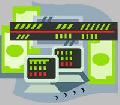
 |
|
| Financial Terms | |
| full costing |
|
Information about financial, finance, business, accounting, payroll, inventory, investment, money, inventory control, stock trading, financial advisor, tax advisor, credit.
Main Page: finance, business, stock trading, investment, payroll, money, credit, accounting, |
Definition of full costing
full costingsee absorption costing
Related Terms:Full faith-and-credit obligationsThe security pledges for larger municipal bond issuers, such as states and Full coupon bondA bond with a coupon equal to the going market rate, thereby, the bond is selling at par. Full priceAlso called dirty price, the price of a bond including accrued interest. Related: flat price. Full-payout leaseSee: financial lease. Full-service leaseAlso called rental lease. Lease in which the lessor promises to maintain and insure the Fully diluted earnings per sharesEarnings per share expressed as if all outstanding convertible securities Fully modified pass-throughsAgency pass-throughs that guarantee the timely payment of both interest and  Absorption costingA method of costing in which all fixed and variable production costs are charged to products or services using an allocation base. Activity-based costingA method of costing that uses cost pools to accumulate the cost of significant business activities and then assigns the costs from the cost pools to products or services based on cost drivers. Full costThe cost of a product/service that includes an allocation of all the (production and Job costingA method of accounting that accumulates the costs of a product/service that is produced either Lifecycle costingAn approach to costing that estimates and accumulates the costs of a product/service over Process costingA method of costing for continuous manufacture in which costs for an accounting compared are compared with production for the same period to determine a cost per unit produced. Target costingA method of costing that is concerned with managing whole-of-life costs of a product/service during the product design phase – the difference between target price (to achieve market share) and the target profit margin. Variable costingA method of costing in which only variable production costs are treated as product costs and in which all fixed (production and non-production) costs are treated as period costs. activity based costing (ABC)A relatively new method advocated for the  absorption costinga cost accumulation and reporting activity-based costing (ABC)a process using multiple cost drivers to predict and allocate costs to products and services; attribute-based costing (ABC II)an extension of activitybased costing using cost-benefit analysis (based on increased customer utility) to choose the product attribute backflush costinga streamlined cost accounting method that speeds up, simplifies, and reduces accounting effort in an environment that minimizes inventory balances, requires direct costingsee variable costing FIFO method (of process costing)the method of cost assignment that computes an average cost per equivalent hybrid costing systema costing system combining characteristics job order costing systema system of product costing used life cycle costingthe accumulation of costs for activities that modified FIFO method (of process costing)the method of cost assignment that uses FIFO to compute a cost per process costing systema method of accumulating and assigning costs to units of production in companies producing large quantities of homogeneous products;  relevant costinga process that compares, to the extent possible strict FIFO method (of process costing)the method of cost assignment that uses FIFO to compute a cost per equivalent unit and, in transferring units from a department, keeps the target costinga method of determining what the cost of a variable costinga cost accumulation and reporting method weighted average method (of process costing)the method of cost assignment that computes an average cost per Absorption costingA methodology under which all manufacturing costs are assigned Activity-based costing (ABC)A cost allocation system that compiles costs and assigns Direct costingA costing methodology that only assigns direct labor and material costs First in, first-out costing method (FIFO)A process costing methodology that assigns the earliest Kaizen costingThe process of continual cost reduction that occurs after a product Process costingA costing methodology that arrives at an individual product cost through the calculation of average costs for large quantities of identical products. Full EmploymentThe level of employment corresponding to the natural rate of unemployment. Full-Employment OutputThe level of output produced by the economy when operating at the natural rate of unemployment. Full-Cost MethodA method of accounting for petroleum exploration and development expenditures Full Credit PeriodThe period of trade credit given by a supplier to its customer. Related to : financial, finance, business, accounting, payroll, inventory, investment, money, inventory control, stock trading, financial advisor, tax advisor, credit. |